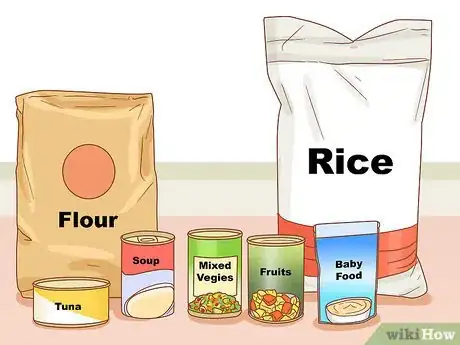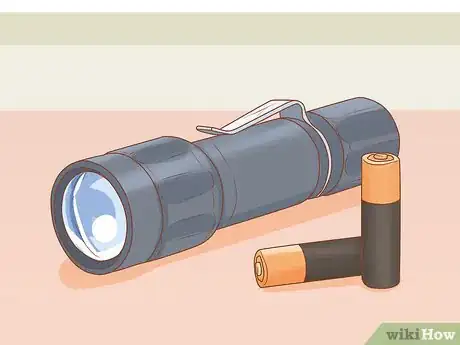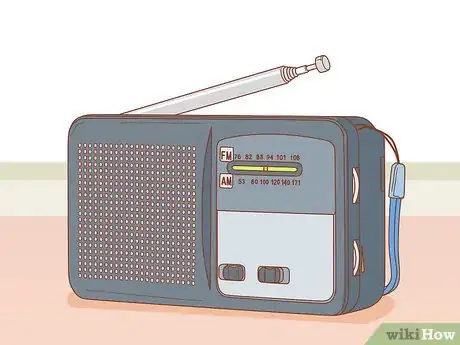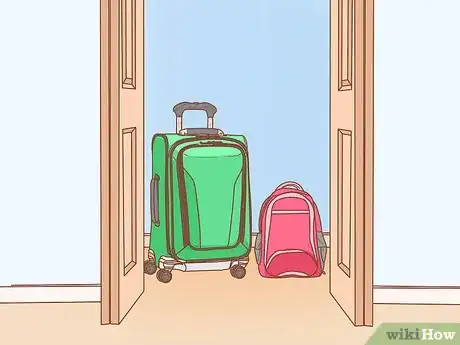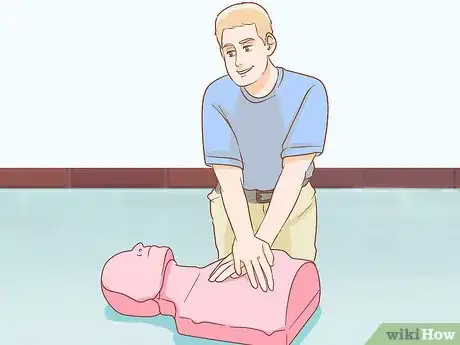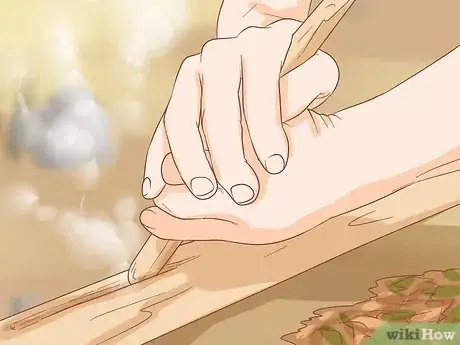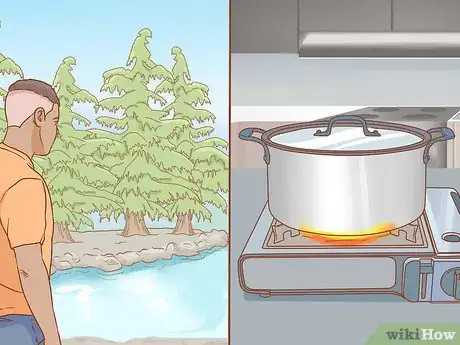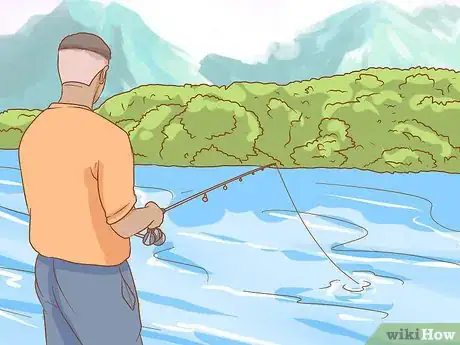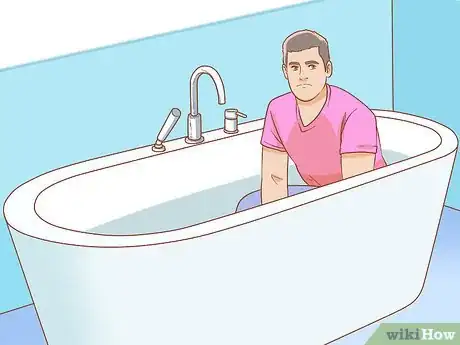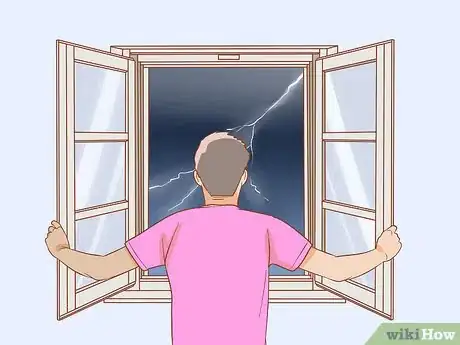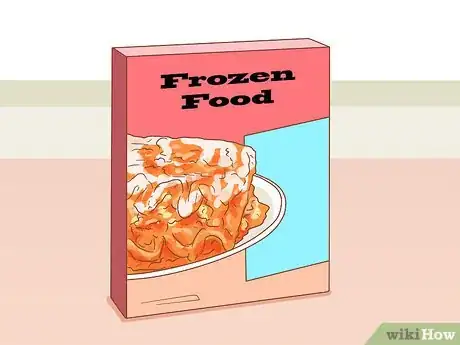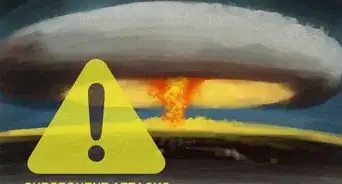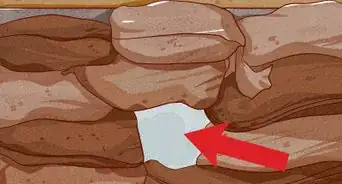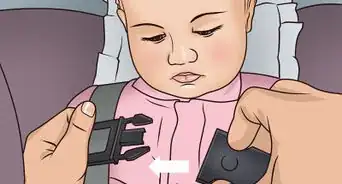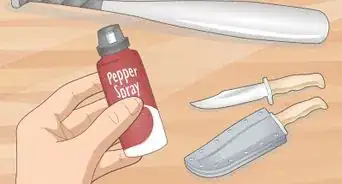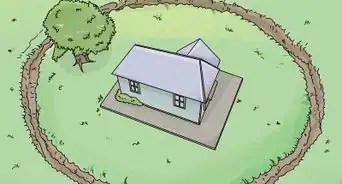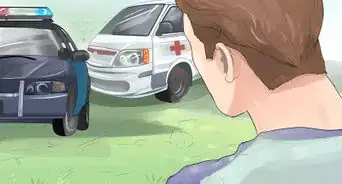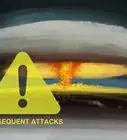This article was co-authored by Britt Edelen and by wikiHow staff writer, Danielle Blinka, MA, MPA. Britt Edelen was an active member of his local Boy Scouts troop near Athens, Georgia from ages 8 to 16. As a Scout, he went on dozens of camping trips, learned and practiced many wilderness survival skills, and spent countless hours appreciating the great outdoors. In addition, Britt worked as a counselor for several summers at an adventure camp in his hometown, which allowed him to share his passion for and knowledge of the outdoors with others.
There are 7 references cited in this article, which can be found at the bottom of the page.
This article has been viewed 72,587 times.
Disasters are rare, so you likely don’t need to worry about them. However, being prepared for a possible disaster will help you survive. No matter what kind of disaster happens, having an emergency kit will guarantee you have the supplies you need. Additionally, it’s helpful to learn survival skills that you can use in the wake of a disaster. If a disaster occurs, stay calm and move indoors.
Steps
Building Your Emergency Kit
-
1Assemble a first aid kit to treat injuries and prevent illness. It’s best to put together your own first aid kit so you can address your personal needs, like prescription medication. However, buy your kit pre-made if that’s what’s easiest for you. At a minimum, your kit should contain:[1]
- Medicines like prescription medications, over-the-counter pain relievers, antibiotic ointments, hydrocortisone cream, antihistamines, cough medicine, and calamine lotion.
- Injury care items like antibacterial wipes, rubbing alcohol, hydrogen peroxide, bandages, instant ice packs, and a tourniquet.
- Products to protect your skin, such as sunscreen and insect repellant.
- Medical supplies like non-latex gloves, a thermometer, tweezers, and scissors.
-
2Collect hygiene supplies to help prevent illness or infection. Personal hygiene is very important after a disaster because disease can spread quickly. Additionally, you may be without water and trash service for some time. Put together a hygiene kit that will help you take care of your bodily needs while also preventing infectious diseases. Include the following items in your hygiene kit:[2]
- Matches in a waterproof container
- Water purification tablets
- Soap
- Hand sanitizer
- Sanitizing wipes
- Toilet paper
- Garbage bags with ties
- Feminine products
- Diapers and wipes, if applicable
Advertisement -
3Store 14 gallons (53 L) of water per person to have enough for 2 weeks. Water is essential for your survival, but you may not have access to fresh water immediately after a disaster. Make sure you have enough water to use for drinking, cooking, bathing, and washing your hands. A good rule of thumb is to have at least 1 gallon (3.8 L) per person per day.[3]
- It’s best to keep enough water for 2 weeks, but this is not possible for most people. For a family of 4, this would mean having 56 gallons (210 L) of water.
- Keep in mind that bottled water does expire. If your water expires, you can use it for bathing or washing your hands. Alternatively, purify it with a water purification tablet.
Tip: If you receive a disaster warning, fill your bathtub, sinks, pots, and other containers with water so that you will have extra. You can use this water to maintain good hygiene or you can purify it for drinking.
-
4Stockpile non-perishable and ready-to-eat foods. Collect canned goods and dried pantry items, like rice. Additionally, get foods that you can eat without cooking them, such as snack crackers or peanut butter. These will last for awhile and are typically easy to eat even if you don’t have electricity. Don't forget to pack a can opener and utensils, as well![4]
- Collect canned foods, including tuna, chicken, vegetables, fruit, beans, and soups. Additionally, store flour, dry beans, dried fruits, pasta, and rice. Include easy-to-eat crackers, cookies, and snacks, which you should store in an airtight container.[5]
- If you have a baby, make sure you have baby food or formula. Similarly, keep extra pet food on hand if you have a pet.
- Throw out dented or bloated canned goods because this is a sign of bacterial growth. If you eat the food, it will likely make you very ill.
-
5Include flashlights and extra batteries as a safe light source. Darkness can become dangerous during a post-disaster power outage. You don’t want to injure yourself or go without access to the things you need, so keep a flashlight and extra batteries so you have light. Use your flashlight sparingly so that you don’t run out of batteries.[6]
- You might also keep candles and matches around to use for lighting. However, they are more dangerous than flashlights because they can cause a fire.
Variation: If you can afford it, solar panels or a generator are useful for powering your home during an extensive electrical outage. Alternatively, use solar powered lanterns for a reusable light source that may last longer than your flashlights.
-
6Get a battery-powered radio to stay updated on what’s happening. A battery-powered or hand crank radio will help you stay tuned in to local news and the NOAA weather broadcast. This will allow you to learn about disaster updates and find out where you can go for services. Make sure you have a radio and a way to power it.[7]
- If your radio uses batteries, keep extras so it doesn’t lose power.
-
7Keep a change of clothes and blanket for each family member. If you’re at home, then you likely have several changes of clothing. However, it’s best to put a change of clothing and blanket with your other supplies so that you can take it if you need to leave your home. This will help you and your family stay warm and dry.[8]
- Long sleeved clothing and pants are best, even during hot weather. They provide more protection from the elements.
-
8Store your emergency kit in a clean, dry place that’s easy to access. Since you’ll be storing food and water, your supplies should be in a room that stays cool. Pick a room in your home that has storage space, like a closet or your kitchen pantry. Then, show everyone in your family where the supplies are stored so you all have access.[9]
- For example, you might store your supplies in the top cabinets in your kitchen or the highest shelf in your pantry.
- If you want your supplies to be easy to move quickly, pack a backpack for each family member to carry. Place these backpacks in a closet or inside your pantry.
Learning Survival Skills
-
1Undergo first aid training so you can tend to medical needs. During a disaster, getting medical care can be difficult. Additionally, it’s easy to get injured because of fallout from the disaster event. Take first aid classes or watch first aid videos online to learn skills you can use to help yourself and others.[10]
- Learn how to administer CPR to adults, children and babies.
- Know the proper way to treat shock.
- Find out how to treat hypothermia.
- Learn how to save someone from drowning.
-
2Practice building fires for warmth, cooking, and boiling water. First, surround your fire with rocks to keep it contained. Then, layer branches at the bottom of your fire pit and pile the wood that will fuel your fire on top. Next, stuff kindling and tinder around the wood. This includes dried pine needles, dry moss, bark, and twigs, which easily catch fire. Finally, light the kindling and tinder with a match.[11]
- If you don’t have a match, you may be able to start a fire by rubbing 2 sticks together as fast as you can.
- You can find videos online that will show you a variety of ways to start fires without a lighter or matches.[12]
- Don’t build a fire inside your home except for inside a working fireplace. Additionally, make sure your fire is far away from nearby structures so they don’t catch fire. If your area has dry conditions, wet the ground around your fire to prevent it from spreading.
-
3Learn how to find water and purify it. If you’re in your home, you can get the water out of your water heater or from the tank of your toilet. When looking for water outdoors, search for a moving waterway, like a river or stream. Additionally, check under green vegetation or under rocks for groundwater. When it rains, collect the fresh rainwater in buckets or pots. Then, use water purification tablets or boiling to purify the water.[13]
- Water purification tablets can quickly purify the water for you.
- Boiling the water for 10 minutes will kill any pathogens that are in it.
Warning: Floodwater is typically unsafe to drink because it contains everything from raw sewage to chemicals. However, you may need to drink it if you’re completely out of water. Before doing so, boil the water for at least 10 minutes. Then, drink only as much as you need to survive.
-
4Practice cooking over an open flame. After a disaster, you may not be able to cook on your stove. If you have a fireplace, you can use it for cooking. Otherwise, use an outdoor grill or camp-stove to heat your food.[14]
- Don’t use a grill or camp-stove indoors because it can be dangerous.
- Most canned goods can be eaten at room temperature, as long as the can isn’t dented or bloated. They may not taste as good, but they won’t make you sick.
-
5Learn how to forage for food. Read books about foraging for food or watch videos online to learn what to look for. If you can, take a course with a naturalist to learn which foods are safe to eat. This may help you stretch your food supplies after a long-term disaster event.[15]
-
6Create an emergency plan with your family members. First, learn what kinds of disaster events are most likely to occur in your area. Then, talk to your family members and decide where you will meet each other if there’s an emergency. Additionally, discuss what supplies you will collect and what skills each person will be able to use during a disaster.[16]
- For instance, your family might decide to meet at home as your first option. However, you may also designate a local park as your back-up meeting spot in the event that you can’t get to your home.
- Decide how you will communicate with your family members, such as by cell phone, by walkie-talkie, or by leaving notes at designated spots, like your home, your kid’s school, or a nearby park.
- Review the escape routes for in case of a fire, and decide which room in your home is safest in case of a tornado or flood.
- Agree on what each family member will carry if you have to leave your home.
- Plan for how you will get in touch with each other if you get separated. For instance, you could all agree to call a specific family member.
Reacting to a Disaster
-
1Stay calm so that you don’t make decisions in a panic. It’s normal to panic during a disaster, and this may cause you to make bad decisions. Instead, take deep breaths and visualize yourself surviving to help calm yourself. Then, keep your focus on what you’ve done to prepare. This can help you stay in control of the situation to help you survive.[17]
- For instance, think about the next step in your disaster plan rather than worrying about what’s happening outside.
-
2Go inside to the sturdiest part of a building for most disasters. Being outside is typically the most dangerous place to be during a disaster. The safest place is inside a building, far away from windows and exterior doors. An interior room is usually the safest place for you to be. Here are some other considerations, depending on the disaster:[18]
- During a flood, move to a higher area in your home, like the second floor. However, don’t go into the attic unless your attic has windows.
- If there’s an earthquake, stand in a doorway to protect yourself from falling debris.
- During a tornado, try to get to the basement. If you don’t have a basement, move to a windowless interior closet, bathroom, or hallway. Then, crouch down and cover your body.
- If there’s a radiation emergency, go inside and shelter in place. Turn off all fans, air conditioners, and heaters. Then, wait until the authorities provide additional information.
-
3Stay low to the ground and crawl to safety if you’re in a fire. First, check to see if there’s smoke coming under your door. If there’s not, check to see if the door feels hot. If there’s no smoke or heat, open the door and slowly crawl to the nearest exit. Once you’re out of the home, call for help.[19]
- If there’s smoke coming from under the door or the door feels hot, don’t open the door because the fire will come inside your room.
- If you can’t get out of the house through a door, try to escape through a window. Even if you can’t climb down, you can yell for help from the window, and firefighters will know where you are.
-
4Stay inside after a natural disaster to avoid dangerous conditions. After the disaster occurs, there will likely be debris, downed power lines, and wild animals. Additionally, there may be flood water. These conditions are very dangerous, so it’s best to stay inside. Don’t go outside unless it’s necessary.[20]
- It’s tempting to go exploring after a storm, but it’s far too dangerous to do so.
- Don’t allow children to swim in flood waters. In addition to being contaminated, they may hide dangerous debris or open manholes that can suck a child down into the sewer.
-
5Limit activity and stay in the shade to reduce your water needs. Since your water will likely be rationed, it’s best to avoid making yourself thirsty. Try to stay still as much as possible so that you won’t exert much energy. Additionally, keep yourself cool by staying in the shade.[21]
- If you can, open a window to cool your home in the aftermath of the disaster.
- Wear cotton clothing so it will trap sweat against your skin. This will help prevent dehydration.
-
6Use insulating material, body heat, and blankets if you need to stay warm. This will help you if the temperature drops or you get wet. Stuff your clothes with paper, bubble wrap, leaves, or rags to help insulate you. Additionally, snuggle up with other people, if you can, because shared body heat will help keep you all warm.[22]
- If you have large rocks, heat them in your fire and use them to help keep you warm. Place them under your blanket or wrap them in a towel before placing them near your skin.
-
7Eat refrigerated and frozen foods first, then eat non-perishable foods. Immediately after the disaster, begin eating your refrigerated food. Continue doing so until they are gone or have started to spoil. Then, consume your frozen foods until they’re gone or spoiled. Finally, use your non-perishable foods.[23]
- Ration your food so you don’t run out of it too quickly. Eat just enough food to support your calorie needs.
- This helps extend your food stockpile for longer.
Expert Q&A
-
QuestionWhat's the first thing you should do if you find yourself stranded or lost somewhere?
 Britt EdelenBritt Edelen was an active member of his local Boy Scouts troop near Athens, Georgia from ages 8 to 16. As a Scout, he went on dozens of camping trips, learned and practiced many wilderness survival skills, and spent countless hours appreciating the great outdoors. In addition, Britt worked as a counselor for several summers at an adventure camp in his hometown, which allowed him to share his passion for and knowledge of the outdoors with others.
Britt EdelenBritt Edelen was an active member of his local Boy Scouts troop near Athens, Georgia from ages 8 to 16. As a Scout, he went on dozens of camping trips, learned and practiced many wilderness survival skills, and spent countless hours appreciating the great outdoors. In addition, Britt worked as a counselor for several summers at an adventure camp in his hometown, which allowed him to share his passion for and knowledge of the outdoors with others.
Outdoor Educator If you're trying to survive, the first thing you're going to need to think about no matter what situation you're in—you could be in a snowy forest or a hot desert—is finding water. That will depend largely on the environment you're in.
If you're trying to survive, the first thing you're going to need to think about no matter what situation you're in—you could be in a snowy forest or a hot desert—is finding water. That will depend largely on the environment you're in. -
QuestionIf you get lost in the wilderness, how do you find your way home?
 Britt EdelenBritt Edelen was an active member of his local Boy Scouts troop near Athens, Georgia from ages 8 to 16. As a Scout, he went on dozens of camping trips, learned and practiced many wilderness survival skills, and spent countless hours appreciating the great outdoors. In addition, Britt worked as a counselor for several summers at an adventure camp in his hometown, which allowed him to share his passion for and knowledge of the outdoors with others.
Britt EdelenBritt Edelen was an active member of his local Boy Scouts troop near Athens, Georgia from ages 8 to 16. As a Scout, he went on dozens of camping trips, learned and practiced many wilderness survival skills, and spent countless hours appreciating the great outdoors. In addition, Britt worked as a counselor for several summers at an adventure camp in his hometown, which allowed him to share his passion for and knowledge of the outdoors with others.
Outdoor Educator You're actually more likely to be found if you sit and stay put. A lot of people tend to think, "Oh, I need to try to figure out where to go to get back to where I was," but that can actually be counterproductive. If you're ever lost, like on a hike, you shouldn't try to move around. You should just sit and figure out a plan, especially if other people knew where you were going. It's way more likely that you'll be found that way.
You're actually more likely to be found if you sit and stay put. A lot of people tend to think, "Oh, I need to try to figure out where to go to get back to where I was," but that can actually be counterproductive. If you're ever lost, like on a hike, you shouldn't try to move around. You should just sit and figure out a plan, especially if other people knew where you were going. It's way more likely that you'll be found that way. -
QuestionHow can I find safe drinking water in a survival situation?
 Britt EdelenBritt Edelen was an active member of his local Boy Scouts troop near Athens, Georgia from ages 8 to 16. As a Scout, he went on dozens of camping trips, learned and practiced many wilderness survival skills, and spent countless hours appreciating the great outdoors. In addition, Britt worked as a counselor for several summers at an adventure camp in his hometown, which allowed him to share his passion for and knowledge of the outdoors with others.
Britt EdelenBritt Edelen was an active member of his local Boy Scouts troop near Athens, Georgia from ages 8 to 16. As a Scout, he went on dozens of camping trips, learned and practiced many wilderness survival skills, and spent countless hours appreciating the great outdoors. In addition, Britt worked as a counselor for several summers at an adventure camp in his hometown, which allowed him to share his passion for and knowledge of the outdoors with others.
Outdoor Educator Try to get to higher ground. Rivers and creeks are more likely to be found at higher elevations, and they flow downward. Follow the river or creek upward to find the source of the water, which will be cleaner since it hasn't been contaminated by anything going down.
Try to get to higher ground. Rivers and creeks are more likely to be found at higher elevations, and they flow downward. Follow the river or creek upward to find the source of the water, which will be cleaner since it hasn't been contaminated by anything going down.
References
- ↑ https://www.cdc.gov/cpr/prepareyourhealth/PersonalNeeds.htm
- ↑ https://www.cdc.gov/cpr/prepareyourhealth/PersonalNeeds.htm
- ↑ https://www.fema.gov/pdf/library/f&web.pdf
- ↑ https://www.fema.gov/pdf/library/f&web.pdf
- ↑ http://www.fema.gov/pdf/library/f&web.pdf
- ↑ https://www.nationalgeographic.com/adventure/features/how-to-survive-natural-disaster-storm-hurricane-expert-tips/
- ↑ https://www.nationalgeographic.com/adventure/features/how-to-survive-natural-disaster-storm-hurricane-expert-tips/
- ↑ https://www.fema.gov/pdf/library/f&web.pdf
- ↑ https://www.nationalgeographic.com/adventure/features/how-to-survive-natural-disaster-storm-hurricane-expert-tips/
- ↑ https://www.nationalgeographic.com/adventure/features/how-to-survive-natural-disaster-storm-hurricane-expert-tips/
- ↑ https://www.youtube.com/watch?v=Ma6VqwIuI24&feature=youtu.be&t=47
- ↑ https://www.youtube.com/watch?v=CVD5KFB7478
- ↑ https://www.nationalgeographic.com/adventure/features/how-to-survive-natural-disaster-storm-hurricane-expert-tips/
- ↑ https://www.nationalgeographic.com/adventure/features/how-to-survive-natural-disaster-storm-hurricane-expert-tips/
- ↑ https://www.nationalgeographic.com/adventure/features/how-to-survive-natural-disaster-storm-hurricane-expert-tips/
- ↑ https://www.nationalgeographic.com/adventure/features/how-to-survive-natural-disaster-storm-hurricane-expert-tips/
- ↑ https://www.nationalgeographic.com/adventure/features/how-to-survive-natural-disaster-storm-hurricane-expert-tips/
- ↑ https://www.nationalgeographic.com/adventure/features/how-to-survive-natural-disaster-storm-hurricane-expert-tips/
- ↑ https://kidshealth.org/en/kids/fire-safety.html
- ↑ https://www.nationalgeographic.com/adventure/features/how-to-survive-natural-disaster-storm-hurricane-expert-tips/
- ↑ https://www.fema.gov/pdf/library/f&web.pdf
- ↑ https://www.nationalgeographic.com/adventure/features/how-to-survive-natural-disaster-storm-hurricane-expert-tips/
- ↑ https://www.fema.gov/pdf/library/f&web.pdf
About This Article
To survive in the case of a natural disaster or other event, prepare an emergency kit by assembling medical supplies, hygiene products, water, canned food, and other crucial items ahead of time. You can create a secure area in your home and store the emergency kit there. Be sure to include extra clothing for various seasons, blankets, and shoes! Finally, it's best to discuss your survival plan with your family to ensure that everyone is on the same page. For more information, including some basic survival skills, read on!



